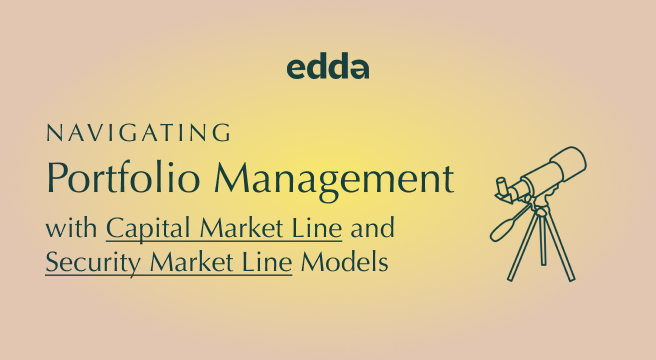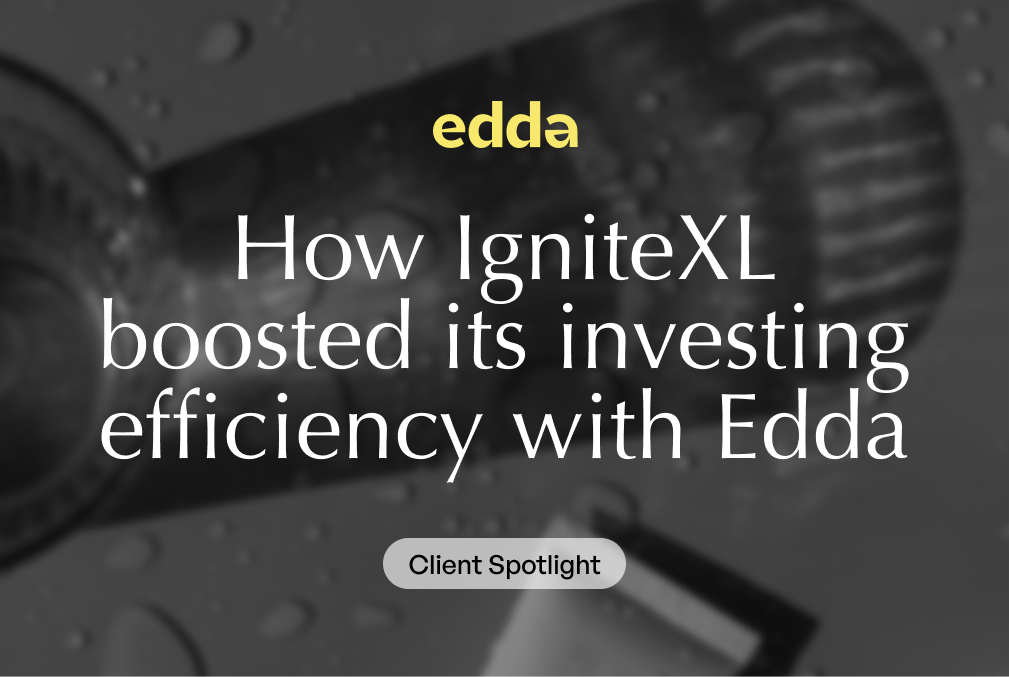Investors often grapple with a multitude of choices, seeking the most beneficial allocation of assets to optimize risk and returns. Two pivotal frameworks, the Capital Market Line (CML) and Security Market Line (SML), offer practical tools in this quest, emanating from the foundational ideas set forth by the Markowitz model.
This article dissects the components of both CML and SML, illuminating their applications and limitations. In addition, discover how Edda can help you effectively manage your investment portfolio with leading venture capital portfolio management software.
Understanding Capital Market Line
The CML serves as an advanced development of the Markowitz Efficient Frontier Model, integrating the concept of a risk-free asset into its analytical framework. Unlike the Efficient Frontier, which solely focuses on risky assets, the CML offers a more expansive view by situating a risk-free rate at its y-intercept and extending a straight line to connect with the ‘market portfolio’ on the Efficient Frontier.
This line visualizes the relationship between expected return and total risk (standard deviation), providing a more comprehensive depiction of investment options that include both risky and risk-free assets.
Applications and Utility
One of the primary uses of the CML is its role in aiding investors to construct a portfolio that includes a mix of risk-free assets, such as treasury bonds, and risky assets like stocks or real estate. By doing so, it creates an opportunity for greater diversification. Moreover, the CML serves as a valuable decision-making tool when it comes to asset allocation. Specifically, it allows investors to identify which blend of risky and risk-free assets will offer the most favorable expected return for an acceptable level of risk.
While the Markowitz model focuses on portfolio optimization through the diversification of risky assets, the Capital Market Line takes the process a step further. It considers how the inclusion of risk-free assets can help investors either reduce risk without compromising return or elevate potential return without increasing risk.
For instance, in low-interest-rate environments, the risk-free rate is generally lower, and the CML will be steeper, indicating higher potential returns for risky assets. Conversely, in high-interest-rate scenarios, the risk-free rate rises, leading to a flatter CML, which suggests lower returns for risky investments compared to risk-free alternatives.
Capital Market Line in Action
An investment firm is looking to optimize its portfolio. It already has a collection of risky assets with an expected return of 10%. The risk-free rate is 3%.
The CML equation is:
Expected Portfolio Return = Risk-free rate + ((Expected Return of Market Portfolio – Risk-free rate) / Standard Deviation of the Market Portfolio) * Standard Deviation of the Portfolio
Here, the CML helps in determining the optimal ratio of risky to risk-free assets in the portfolio for a given level of risk (standard deviation). By using the CML, the firm can assess how much of its capital should be allocated to the market portfolio and how much should be kept in risk-free assets to achieve an optimal risk-return profile.
For example, if the firm’s portfolio standard deviation is 15%, and the market portfolio’s standard deviation is 20%, the CML could guide them to achieve a calculated expected portfolio return, helping in rebalancing strategy.
Understanding Security Market Line
The SML offers an approach that is more granular compared to the CML, honing in on individual assets rather than portfolios. It serves as the graphical embodiment of the Capital Asset Pricing Model (CAPM), a model that establishes an asset’s expected return based on its systemic risk, often referred to as ‘beta’.
This risk is the asset’s volatility in relation to the broader market. The SML plots expected asset returns on the y-axis against the asset’s beta on the x-axis, serving as a practical guide for assessing risk-adjusted performance of distinct securities.
Applications and Utility
One significant utility of the SML is its ability to establish a minimum acceptable rate of return for an asset, given its risk profile. Investments falling above the SML are generally considered undervalued and thus more attractive, as they offer a return that exceeds the expected return for their given level of risk.
On the contrary, investments that fall below the SML are often seen as overvalued, since they offer less return than what would be deemed acceptable for their risk level.
Security Market Line in Action
An investor is contemplating adding a new technology stock to their portfolio. They’ve identified two options: Stock A with a Beta of 1.2 and expected return of 12%, and Stock B with a Beta of 0.9 and expected return of 9%. The risk-free rate is 2%, and the market return is 8%.
The SML equation is generally represented as:
Expected Return = Risk-free rate + Beta * (Market Return – Risk-free rate)
For Stock A, using the SML equation yields an expected return of 2.
For Stock B, the expected return would be 2.
Stock A’s real expected return of 12% surpasses the SML-expected return of 9.2%, making it undervalued. Stock B’s real expected return of 9% is also above the SML-expected 7.4%, indicating it too is undervalued. Both are good candidates, but Stock A offers a higher excess return over what is predicted by its beta.
Comparative Analysis: CML and SML
Both the CML and SML share a commonality in that they engage with the concept of a market portfolio. However, their areas of focus and applications diverge significantly. While the CML provides a framework for understanding how to balance an entire portfolio that may consist of risky and risk-free assets, the SML narrows its gaze to individual securities and their respective risk-return trade-offs in relation to market volatility.
The CML is more focused on portfolio construction, aiming to find the most efficient blend of risky and risk-free assets. On the other hand, the SML aims to scrutinize individual securities to assess whether they are properly priced based on their risk profiles. Each serves a distinct purpose, but together they offer a comprehensive set of tools for both portfolio construction and asset selection, each contributing valuable perspectives on risk assessment and return optimization.
Limitations of CML and SML Models
The applicability of the CML and SML can be compromised under certain conditions, leading to potentially skewed or misleading results. For the CML, one of the core assumptions is that all investors can borrow and lend money at a risk-free rate, which isn’t always the case.
If an investor is limited in their ability to access risk-free rates—for instance, due to credit restrictions—then the CML’s predictions about optimal asset allocations may not hold. Additionally, the CML assumes a singular optimal ‘market portfolio,’ which can be unrealistic, especially in markets that are not entirely efficient or in the presence of trading restrictions, taxes, or other frictions.
Similarly, the SML is rooted in the CAPM, which assumes that markets are efficient and that all investors have access to the same information. These assumptions often do not hold in the real world, where information asymmetry and behavioral factors can influence asset prices.
The SML also assumes that an asset’s risk can be fully captured by its beta, ignoring unsystematic risks that might be unique to a particular company or sector. This can make the SML less useful for assets that have substantial idiosyncratic risks not correlated with the broader market.
While both the CML and SML offer valuable insights under specific conditions, their efficacy can diminish in the presence of market imperfections, frictions, or varying access to financial resources among investors. These models are best utilized as part of a broader analytical toolkit rather than standalone decision-making frameworks.
An Overview of Edda’s Portfolio Management Software
What is the best software for portfolio management?
Edda’s deal-sourcing platform and venture capital portfolio management software offers an all-inclusive solution that addresses the complexities of venture capital investments by harnessing the analytical capabilities of CML and SML. By aggregating real-time data on both risky and less volatile assets, the software calculates optimal asset allocation strategies and expected portfolio returns, fulfilling the role traditionally served by the CML. Simultaneously, its deal-sourcing algorithms leverage SML analyses to evaluate systemic risks of potential investments, thereby streamlining the dealflow process.
In addition to asset allocation and deal evaluation, the platform serves as a specialized dealflow CRM for venture capital. This integrated approach saves firms from the operational inefficiency of navigating multiple systems and promotes a unified, data-driven strategy.
Edda’s venture capital management software synthesizes complex financial theories with practical investment solutions, delivering a well-rounded tool for venture capital firms. Its real-time adaptive algorithms and comprehensive functionalities make it an essential asset for firms looking to efficiently manage their portfolios and make informed investment choices.









